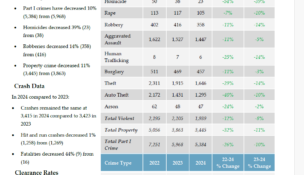Sentencing Case Analysis
By: dmc-admin//April 9, 2007//
The decision provides a wealth of useful persuasive authority for defense attorneys arguing for below-guideline sentences.
Anyone involved in the criminal justice system for any length of time inevitably comes across a particular breed of defendant — a woman who is seems far more likely to be in court as a domestic violence victim than as a criminal, but is charged with abetting a boyfriend’s crimes.
State courts have always been free to acknowledge this and show leniency to such defendants. With the demise of mandatory guidelines, they can now receive some leniency in federal court, too.
However, attorneys should beware of quoting from the decision too much, as it contains hyperbole that could irk some courts.
For example: “Current drug laws punish not just those who sell drugs, but also a wide range of people who help or associate with those who sell drugs”; and “In too many cases, women are punished for the act of remaining with a boyfriend or husband engaged in drug activity, who is typically the father of her children.”
In truth, however, whatever coercion may influence the decision of a woman, or anyone else, to get involved in the criminal activity, criminal intent is still a necessary element of any crime. By the time of sentencing, the defendant will either have admitted criminal intent, or been found to have criminal intent beyond a reasonable doubt, by a unanimous jury.
Simply emphasizing the difficult position the defendant was in is likely to get more favorable treatment from most courts than suggesting that the defendant’s only crime is association, or not breaking up with a bad boyfriend. In fact, making such arguments places a defendant at risk of losing credit for accepting responsibility.
The court’s discussion of why the 100:1 crack to powder cocaine is also an excellent source for making an argument for a below-guideline sentence in other crack cases.
A defendant who is actively engaged in dealing crack has made a deliberate choice to distribute crack, instead of powder cocaine. A defendant who is only a mule, or as here, only abets the trafficking by driving the car, has made no specific choice to transport crack instead of powder cocaine. That alone is a good reason for a below-guideline sentence.
The court’s imposition of a below-guideline sentence based on lack of control over the amount distributed is also reasonable. If a defendant’s role in a conspiracy is that of mule, she really has no control over the amount.
A mule who transports 2 kilograms of controlled substances is no more morally culpable than one who transports a half-kilogram. When sentencing a mule, rather than an active participant in the drug trade, the drug quantity table in U.S.S.G 2D1.1 effectively dictates random sentences divorced from actual culpability.
In this part of the discussion, too, however, the court might be overreaching, when it adds, “Nor was there any evidence of specific harmful effects on the community resulting from the offense, or of any specific victims of the crime.”
However, this statement holds true in most controlled substance cases. Prosecutors can’t reasonably be expected to produce individuals from the community that a drug dealer has turned from straight-A students into degenerates. Harm to the community from dealing crack can be, and should be, inferred.
Finally, attorneys would be wise to avoid requesting a lower sentence based on the defendant’s race.
The court wrote, “Finally, defendant was African-American, as are the vast majority of those sentenced for trafficking in crack while powder cocaine offenders are usually white. This raised the specter of racial disparity, the most pernicious type.”
Were this case to be appealed, this statement would be grounds for summary vacation of the sentence and remand for resentencing.
U.S.S.G. 5H1.10 explicitly states that race is not relevant in the determination of a sentence, and even if it did not, the Equal Protection Clause would still require vacation of the sentence.
In U.S. v. Wallace, 458 F.3d 606, 608 (7th Cir. 2006), the Seventh Circuit observed, “Freed from the mandatory nature of [the guidelines’] structure, the court [is] free to consider the factors outlined in 18 U.S.C. § 3553(a), including those that were specifically prohibited by the guidelines and those that are not constitutionally prohibited such as race or sex (emphasis added).”
It is unfathomable that the Seventh Circuit would permit a reduction of the disparity between African-American and white defendants generally, by approving leniency for an individual defendant because of her race.
As a whole though, the court’s opinion provides several good arguments for below-guideline sentences when the defendant is a low-level actor in a crack conspiracy.
Click here for Main Story.
David Ziemer can be reached by email.
Legal News
- Steven Avery prosecutor Ken Kratz admits ‘mistakes were made’
- Colombian national extradited to Milwaukee faces International narcotics-trafficking conspiracy charge
- MPD: Milwaukee homicides down nearly 40 percent compared to last year
- EVERS: Republican lawmakers No-Show at special meeting to release statewide PFAS funding, stabilize healthcare access
- Wisconsin ICAC Task Force conference on Missing and Exploited Children highlights increase in sextortion cases
- More than 300 Wisconsin officers back in law enforcement after being fired or forced out
- Former Trump staffer who said to ‘fan the flame’ after 2020 loss hired to lead Wisconsin GOP
- Gov. Evers appoints David Casey to Serve as DOR Secretary
- Former Marine sentenced for Molotov Cocktail attack against Planned Parenthood Clinic
- ABA names 34th Annual Margaret Brent Women Lawyers of Achievement Awards honorees
- FBI launches criminal investigation into Key Bridge collapse
- Man charged in slaying after woman’s leg found at Milwaukee-area park
WLJ People
- Power 30 Personal Injury Attorneys – Russell Nicolet
- Power 30 Personal Injury Attorneys – Benjamin Nicolet
- Power 30 Personal Injury Attorneys – Dustin T. Woehl
- Power 30 Personal Injury Attorneys – Katherine Metzger
- Power 30 Personal Injury Attorneys – Joseph Ryan
- Power 30 Personal Injury Attorneys – James M. Ryan
- Power 30 Personal Injury Attorneys – Dana Wachs
- Power 30 Personal Injury Attorneys – Mark L. Thomsen
- Power 30 Personal Injury Attorneys – Matthew Lein
- Power 30 Personal Injury Attorneys – Jeffrey A. Pitman
- Power 30 Personal Injury Attorneys – William Pemberton
- Power 30 Personal Injury Attorneys – Howard S. Sicula











